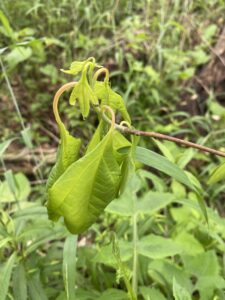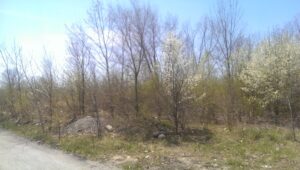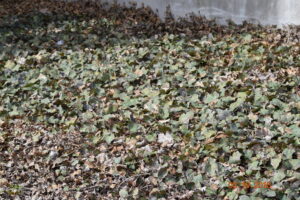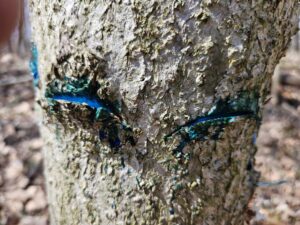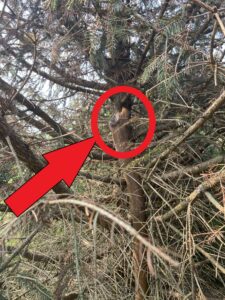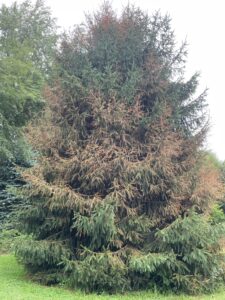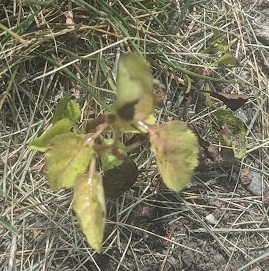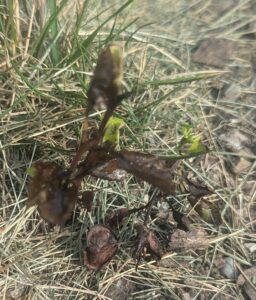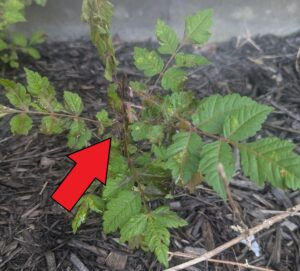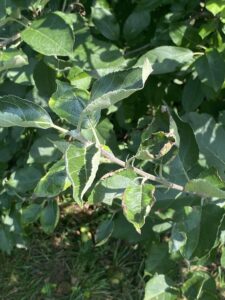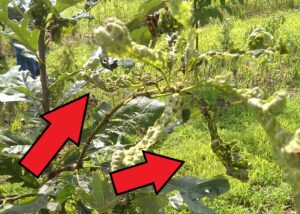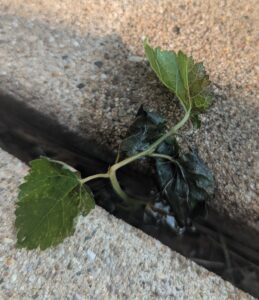There have been a significant number of questions and problems regarding triclopyr that have come across my desk this growing season. Several of these problems have come through the Purdue Plant and Pest Diagnostic Laboratory (https://ag.purdue.edu/department/btny/ppdl/index.html) from landscapers, nurseries, and property managers.
General Information about Triclopyr
Triclopyr is a selective systemic herbicide belonging to the pyridine class. It is primarily used to manage woody plants, vines, and some broadleaf weeds. Unlike glyphosate, a broad-spectrum herbicide, triclopyr specifically targets the growth hormones in dicotyledonous plants, making it effective in controlling species that are difficult to manage with other herbicides. It works by mimicking plant hormones, disrupting normal growth processes, and leading to the death of the treated plant (Fig. 1).
- Figure 1. Confirmed damage from triclopyr on sassafras shows the growth regulator-type injury on leaves. Photo courtesy of the Office of the Indiana State Chemist.
What Triclopyr Controls
Triclopyr is utilized in various settings to control unwanted vegetation. It is effective against species such as:
- Woody Plants: Includes trees like tree of heaven and callery pear and shrubs like autumn olive and honeysuckle (Fig. 2).
- Vines: Particularly those that can outcompete native flora, such as kudzu or English ivy (Fig. 3).
- Broadleaf Weeds: Some herbaceous plants that pose ecological or agricultural problems.
- Figure 2. Invasive plants, such as, Pyrus calleryana (callery pear) can be controlled by triclopyr.
- Figure 3. Invasive vines, such as Hedera helix (English ivy) can be controlled via multiple applications of triclopyr.
Where and When Triclopyr is Used
Triclopyr is applied in a range of environments, including:
- Forestry: To clear invasive species and manage forest regeneration.
- Agriculture: To control weeds and shrubs that interfere with crop production.
- Aquatic Areas: Formulations that are safe for aquatic environments help manage invasive species near water bodies.
- Rights-of-Way: To maintain clear paths and prevent the spread of invasive plants.
Timing of application is crucial. Triclopyr is most effective when applied during the growing season when plants are actively taking up nutrients and can transport the herbicide throughout their system.
Movement in the Plant
Triclopyr is absorbed through foliage and roots and is translocated systematically within the plant. Once inside, it moves upward through the xylem and downward through the phloem (ambimobile). This systemic movement allows triclopyr to affect not just the treated areas but also parts of the plant that are not directly sprayed. This attribute makes it effective for managing large, established plants, specifically through hack and squirt treatments (Fig. 4).
- Figure 4. Hack and squirt treatments with triclopyr is a common method to control invasive trees. Photo by Lenny Farlee.
Phytotoxicity to Off-Target Plants
Many applicators have experienced off-target damage when they report minimal drift. Most often, this damage has been primarily thought to be either volatilization or root exudation, (or via root grafts) (Figs. 5 and 6).
- Figure 5. A cut stump treatment of mulberry where triclopyr was applied only to the cut-off portion of the mulberry. Photo courtesy of the Purdue Plant and Pest Diagnostic Lab.
- Figure 6. Norway spruce damage from a cut stump treatment of mulberry within the canopy of the spruce. Photo courtesy of the Purdue Plant and Pest Diagnostic Lab.
Volatilization Potential
Triclopyr has a relatively high volatility compared to some other herbicides, especially the ester formulation. This characteristic can increase the risk of volatility when certain environmental factors are present, such as increased temperatures and lower humidity.
Off-Target Damage Due to Root Exudation
A significant concern with triclopyr is its potential for damage through root exudation but previously was only speculation. Recent research has shown that off-target damage can occur via root exudation (Oberweger et.al., 2023 and Graziano et.al., 2022). These studies found that triclopyr can be excreted from the roots of treated plants into the soil, where it can affect nearby vegetation (Figure 7).
- Figure 7. Triclopyr concentration (μg L−1) detected in mesocosm wells at 7, 21, 35, and 42 d after treatment in the triclopyr root exudation study. Triclopyr concentrations were derived only for treatments that included basal bark oil applications with triclopyr at 34 g L−1 with and without a 5-cm layer of powdered activated charcoal placed at the surface of the mesocosm. Error bars represent 1 standard error of the mean (N = 8). Taken from: Oberweger CA, Enloe SF, Wilson PC, Prince CM, Sperry BP, Hinz FO (2024) Physical and physiological pathways of off target triclopyr movement and associated nontarget injury following basal bark application. Weed Sci. 72: 68–75. doi: 10.1017/wsc.2023.62
Root exudation may lead to:
- Soil Contamination: Residual triclopyr in the soil can impact plant growth and health in the vicinity.
- Non-Target Plant Damage: Plants growing near the treated area might suffer from root absorption of triclopyr, leading to stunted growth or even death.
Studies have shown that while triclopyr’s mobility in soil is relatively low, persistence in the rhizosphere can still impact sensitive species. There is still some speculation that damage could occur via root grafting and/or mycorrhizae between plants, but research is still unclear at this time.
Symptoms of Triclopyr Damage
There are a few symptoms that occur when triclopyr damage is suspected, which are similar to other growth regulator herbicides. Symptoms can be seen on small weeds in the sun in as little as two hours, while symptoms on larger plants or in shade can take 48 hours or more (Figs. 8a, 8b, and 9).
- Figure 8a. Before triclopyr was applied to callery pear root sucker.
- Figure 8b. Triclopyr applied to callery pear root sucker after two hours and 15 minutes in the sun.
- Figure 9. 22 hours after a triclopyr application to goldenrain tree in the shade. Notice the apical growing point beginning to show symptoms.
- Epinasty: Twisting, curling, and cupping of leaves and petioles are a common symptom of triclopyr damage (Figure 10).
- Figure 10. Cupping of apple leaves after a misapplication of triclopyr. Photo courtesy of the Office of the Indiana State Chemist Office.
- Strapping: Strapping is when a leaf elongates and decreases in width. The leaves can also have leaf margins that are significantly different from a non-affected leaf (Figure 11).
- Figure 11. Strapping of leaves is common herbicide injury symptom.
- Water-soaked appearance: Leaves can become darkened and wilted (Figure 12).
- Figure 12. Water-soaked appearance occurs with some herbicides, such as triclopyr. Weed was sprayed with triclopyr two hours prior to water-soaked leaves in full sun.
- Necrosis: Blackening (death) of leaves is usually first seen in new growth.
- Spiraling Damage on Evergreens: Due to the differences in vascular tissue between deciduous and evergreens, spiraling damage can be found on evergreens with systemic herbicides (Figure 13).
- Figure 13. Due to the vascular bundle arrangement in evergreens, some herbicides, such as triclopyr, can cause symptoms in a spiral around the trees.
Conclusion
Triclopyr is a valuable tool for managing invasive and woody plants, with its systemic action making it effective for large and stubborn species. However, its use requires careful management to mitigate potential risks to non-target plants and ecosystems. Understanding its movement within plants, potential for volatilization, and impacts through root exudation can help minimize unintended damage and ensuring that its benefits are maximized while its drawbacks are minimized.
References:
- Graziano G, Tomco P, Seefeldt S, Mulder CPH, Redman Z (2022). Herbicides in unexpected places: non-target impacts from tree root exudation of aminopyralid and triclopyr following basal bark treatments of invasive chokecherry (Prunus padus) in Alaska. Weed Sci. 70: 706–714.doi: 10.1017/wsc.2022.61
- Oberweger CA, Enloe SF, Wilson PC, Prince CM, Sperry BP, Hinz FO (2024) Physical and physiological pathways of off target triclopyr movement and associated nontarget injury following basal bark application. Weed Sci. 72: 68–75. doi: 10.1017/wsc.2023.62
